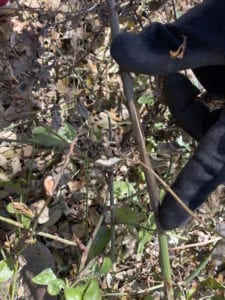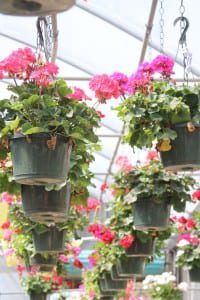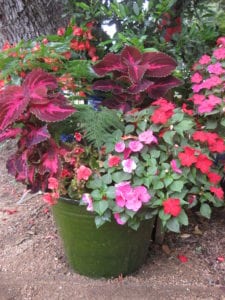For those of you still waiting patiently to see how your plants fair after the freeze, kudos to you! It’s been a hard wait, and for many plants, the wait isn’t over yet. Experts in the horticulture world want us to know that it may take weeks, and for some plants, months to truly see the extent of some damage.
Sorry if you are tired of hearing this but many customers are still needing the answer so here it is again, “No, there really isn’t anything you can do to speed up the healing/recovery process of your plants. It just takes regular watering and time in warm weather. That’s it plain and simple.
It’s a bit tough for us to give you advice as to whether or not your plants have survived the freeze or not without allowing them ample time to recover. (Also, we don’t know how, or if, you protected them.) Just because it is brown, does not mean it is dead. Do you see what I’m getting at here? We just don’t know at this point.
Factors like the many microclimates we have throughout our city and within our own landscapes make it even harder to be able to advise if plants will come back or not. You could have some plants that are completely unscathed and some that are demolished, just because of their location in your landscape. (One area is protected by a tree canopy, one area is more exposed to wind, one area is nestled in a trench, one area is right out in the open, etc…)




What Can You Expect From Plants After A Deep Freeze?
Even if your plants do recover from the freeze, this year, you’ll most likely see a different plant than you are used to. We all may have to face certain realities about our plants due to the severe freeze. Let’s take a look at a few.
-Tropical perennials like bougainvillea may not start to put on new growth until early summer (or later). And even if it does start tot grow, you may not see any blooms until much later, if you see blooms at all this year! See what’s going on here?
-You shouldn’t expect to see much fruit this year from citrus or less hardy fruit trees like fig, avocado, etc… that were damaged by the freeze. You most likely won’t get fruit at all. If there is damage below the graft line of the citrus, it’s time to get a new one. Any fruit produced from a citrus tree that has been damaged below the graft line will be mouth-puckering sour orange. Blech!
-Evergreen woody shrubs that were damaged will most likely not bloom this year. New growth will sprout from the ground or current limbs, and at that time you can prune them.
-Damaged roses will probably not produce again until fall, wait to clearly see damage between dead and healthy plant material to prune.
-Many have asked about sago palms. You should only be cutting off dead fronds for now and wait for warm weather to see if they sprout from the center.
-Some perennials that survived might wait until summer or fall for blooms, and tropical perennials that normally take a bit longer to reemerge anyway (Pride of Barbados), could take much longer… IF they come back at all! BUT… it will all take time to tell.
Unfortunately, the name of the game is still: WAIT. What you will need to do is decide if you CAN wait. We understand the worry and frustration. If you have to wait until late spring or early summer to see if a plant is going to come back and it doesn’t, that puts you in a bad spot of planting when the heat of summer is about to hit. Not the ideal time to get a plant established.
If you don’t wait to see if it comes back and yank the plant out, you lose the money (and time, oh, the time) you invested in the original plant plus the money for a new plant. Those choices stink! And yet, they are the choices most of us are going to be facing.




The thing to realize is that there is always something to do while you’re waiting. This year might need to be considered a recovery year for many of our landscape specimens. We may have to allow them time to go through an “ugly duckling” stage in order to get back to their full potential. In the meantime, there are plenty of options to keep you busy and in touch with your inner gardener.
Fill up your landscape with inexpensive, yet colorful and impactful spring annuals. Plant them around those specimens waiting to wake up and their cheerful hues will give you hope as you wait for plant life to reappear. Build a raised bed for vegetables, grow an herb garden in a beautiful pot, plant that new shrub or tree specimen you’ve been debating about for awhile, finally replace some of your water-hungry turf with a groundcover, gather up all your fallen leaves for the compost pile, or hang some gorgeous baskets full of vibrant geraniums or mandevilla.
Whether you decide to wait it out, or pull them out, we aren’t here to judge you. I mean, we are in the business of selling plants after all. We just want you to have the info to make your own decisions. We are doing our best to bring fresh plant material into both of our Rainbow Gardens locations to help you replace plants damaged from the freeze. Whatever your gardening needs are, we hope to see you soon!
~The Happy Gardener, Lisa Mulroy


Can you give information on succulents, aloes and agaves aa to which ones will most likely need to be pulled out based on how mushy they are and look.
Hi Lori,
It’s not really a degree of mushiness, but rather that you should cut be cutting off ALL mushy parts of the succulents, aloes and agaves. Anything that has turned to mush will not be rejuvenating itself. Their are a ton of factors that go in to assessing freeze damage individually (were plants protected, were they in ground or pots, where do you live in the city, how old were plants, etc…). Sorry, I know it’s not what you want to hear, but cutting back the mush and waiting for warm weather to see if anything sprouts up is the best we got right now. Cut back mush, wait for anything left to callous over before watering normally.
I go every two weeks to your location. This year I bought the climing Roses, white, pink and red and others to replace them with those that died. It is one of my favorite places to visit. congratulations on how quickly you have recovered. But how difficult it is to find help, when I need a recommendation, or some help in general.
Junna,
Thank you so much for continuing to visit us and we are so happy you found some climbing roses to replace what you lost. Spring is always crazy busy around the nurseries and this spring is even more so due to all the unusual circumstances from the freeze. Our employees are all over the place restocking the nursery. However, we want nothing more than to help out our customers with all their gardening needs, so when you see an employee pass by, don’t hesitate to stop us to ask your questions. I promise we are there, and we want to help you!
Lisa wrote the most honest and informative article that I have read about the “Polar Pop” we suffered through and it’s effect on our garden friends. Take away: Patience, Patience, Patience.
Hi Pete,
Thank you so much for your kind words and for reading the article too! Best of luck in all of your gardening endeavors, and I sure hope your plants reward your patience with some new growth!
Like everyone else , there was a cemetery of death plants in my garden.
The one I worry the most is my banana leaf plants -tropical . I had over 7 huge ones and now I have 4 …sigh. Their stems are very squshy (if that is a term) , so on some I cut down the way to the bottom but left the root still in there to be hopeful.
On these, do I still wait , do I water to see what happens?
Your advice is appreciated .
Hi Sandra,
Squishy or mushy is definitely a term we’ve used on some of our tropicals with more fleshy stems and trunks. Yes, you’ve done right! Cut off all the mush/squish, and if there is anything left, it could quite possibly come back. Do not overwater, but offer regular amounts and allow the warmth of the sun to work it’s magic. It may take a little longer than usual.
We have a grapefruit tree that has produced wonderful ruby red fruit for at least 11 years. the freeze hit it hard this year. Should we call an arborist to trim or just wait to see if it produces new leaves and flowers?
Hi Ursula,
It’s up to you if you’d like to hire an arborist or tackle the pruning yourself, but what we would advise is to wait until the new growth has commenced. Freeze damage sometimes shows up later. Here is a great article explaining why you should wait to prune citrus until later. Make sure any arborist you hire can explain what they are doing and why.
Great advice and thank you, Lisa! Our poor sago palm looks pretty dead. We cut off everything and left it in the pot to see what might happen. Barbados looks dead. Bougainvillea is sprouting tiny leaves. (Brought it into laundry room which was mostly same temp as outdoors minus wind.)
Our beautiful bay leaf tree we transplanted into a half-barrel last Easter, looks sad. My husband covered it with a big tarp and put a little electric heating pad at the base. Luckily, we never lost power. It kept the temp about 5* warmer than outside the tarp is all. 12* above zero when outside was 7* above.
Yesterday, I cut off all the dead leaves and some obviously dead branches. The middle part seems like it might be okay. And right at the bottom, near the soil, some fresh, new baby leaves sprouting!
Tarragon looked completely gone. Pulled out all the dead stuff… and voila! New baby green leaves shooting up from the base. Amazing!
Got some new herbs and lotsa new hanging pots at Rainbow – Bandera yesterday. Repotting many of our hanging plants that came indoors during the freeze, even though it was pretty cold inside, too. Not as frigid as out. We had no water, so they dried out.
Thanks for your excellent wisdom on how we can have patience and hope for our gardens and plants after polar vortex came to visit for way longer than any of us imagined possible.
Suz,
YAY! So happy to hear that many of your plants sound like they are working hard to come back to you! Sounds like you are doing everything right to get them moving in the right direction too! Thank you so much for reading and best of luck with all your plant babies!
I am happy to report that I see small buds growing on my blue plumbago and lantana. I cut them back just this weekend. Cut all the mushy off various plants that were in my neighbors greenhouse. Hoping for the best.
Hi Denise,
Sooooooo happy to hear that! Please do let me know how they all turn out. Maybe we will all have the thickest, lushest plants after having to cut them down so far! Best of luck! Thanks so much for reading!
I have several long runs of Viburnum hedges. They were hit really hard. All the brown leaves are falling off and I see lots of naked branches and twigs. Should I cut them down to about 2 feet from the ground and see what happens or just wait another month? The hedges were about 6 fee tall and provided privacy. Such a shame and they were starting to bloom before the freeze. I see lots of new growth all around the yard, with various plants, which is kind of exciting to see the regeneration. I appreciate your article and all the great advice.
Hi Colleen,
You might not have to cut back that far. It may still take a little while to see the clear damage, and then you can just cut back to the healthy material. That being said, if new growth ends up just popping up from the roots, you might be cutting back that far. As you stated, you’ve luckily been seeing some regeneration of other plants, so I’d wait a little longer for your viburnum. If there are obvious dead branches you can remove them if you can’t stand it.
My Cenizos are starting to put on new leaves, but there is still a lot of damaged foliage. Usually I prune my cenizos pretty significantly in March. This year I’m concerned that pruning them will remove the new leaves they need to recover. Since damaged leaves and new ones are often close together on the same stems, what should I do? Prune or skip pruning this year? Thanks
Hi Jayne,
Please consider waiting a little longer until the exact damaged or dead areas are determined. Most of the damaged foliage should fall off, and you will be able to see any tips of branches that need pruning. From the information you gave me that some limbs have new growth on same limbs as the damaged foliage, I wouldn’t prune those limbs until you see a definitive stop of new growth. You might just have a few snips to make, or you can plan to prune your cenizo this year in early summer.
I cut the mushy part off but new plants grew from the roots.
Yay! Happy to hear that Barbara! We were so excited at the number of plants that made their way back after the freeze.
I am a new resident in TX. I have several Oak trees in my backyard that look sickly. I think they are Live Oak. They’ve been shedding leaves all summer and have thin foliage. Are they Polar Vortex damaged or just sick or OK?
Hi Marcia,
Do you have pictures that you can send in? Without seeing them, we wouldn’t be able to diagnose the issue, and even then, it’s probably advisable to contact an arborist to know if your oak tree is truly sick. Where do you live in Texas? Some of our native trees did suffer from SNOVID, but oak trees are also susceptible to oak wilt. Has there been any pruning of the oak trees and if so at what time of year?